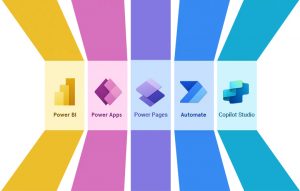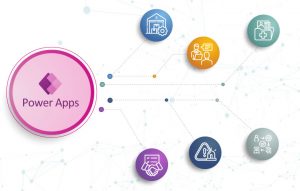Mixed reality tools like HoloLens have gained significant traction in recent years, with many businesses looking to leverage the power of augmented and virtual reality in their operations. However, developing HoloLens apps can be a daunting task. To simplify the application building process, Microsoft has created Power Apps, a low-code and no-code development platform that allows businesses to easily create custom applications for mixed reality (MR). Integrating these two powerful tools can result in a low-code solution for HoloLens 2 that revolutionizes many industries.
Power Apps applications can be built in three ways:
1. Canvas apps – where controls are dragged and dropped onto a design surface.
2. Model-driven apps – assists developers to build complex and data-rich apps with minimal coding.
3. Portal apps – a platform to build external-facing websites that allow external users to interact with data stored in the Microsoft Dataverse or other external systems.
When PowerApps and HoloLens are integrated, they facilitate the development of model-driven and MR apps to effortlessly manage 3D assets, images, and other content. The result is a unique and immersive experience as users engage with virtual objects in the physical world.
Forrester Consulting conducted a study on the Total Economic Impact™ of Microsoft Power Platform Premium Capabilities and found that businesses are experiencing a 140% ROI and reducing application development costs by 45% with the use of the platform.
The emerging role of mixed reality in various industries
Mixed reality app development with Power Apps has opened up new opportunities for businesses to create immersive and interactive experiences for their users in different industries, such as:
- The manufacturing industry uses MR apps to provide real-time assistance to technicians, enable remote collaboration and training, and improve quality control. For example, Airbus uses HoloLens mixed reality headsets to help workers assemble complex aircraft components.
- The retail industry is leveraging MR apps to provide virtual try-on experiences, visualize products in 3D, improve in-store navigation, conduct store audits and streamline in-store operations. For example, the HoloLens Shopping Experience app enables customers to visualize and interact with virtual products in a physical retail environment.
- The healthcare industry is planning surgeries, training medical students and educating patients using mixed reality apps. For example, HoloSurg is a mixed reality app developed using Power Apps that helps surgeons plan and practice procedures. Surgeons create a holographic model of the patient’s anatomy. This enables them to practice the procedure in a virtual environment before performing it on the patient.
- The architecture and construction industry uses mixed reality apps to create 3D models of buildings and visualize them in real-world environments. For example, Trimble Connect is a mixed reality app developed using Power Apps for architects, engineers, and construction professionals. It allows them to collaborate on 3D models and share data in real-time.
Mixed reality app development with Power Apps has unlocked a world of possibilities for various industries. From enhancing the customer experience to improving business efficiency, the integration of mixed reality and Power Apps has become a game-changer. Let’s consider a few use cases where PowerApps and mixed reality are used together to develop low-code and no-code solutions for HoloLens 2.
Mixed reality product catalog apps for sales engineers
Microsoft PowerApps development of mixed reality has resulted in several product catalog apps that enhance the sales process by providing an interactive experience.
Hologic, a medical device company and Square One- an insurance services provider, developed a product catalog app using Power Apps. The apps allow their sales team to showcase their products and answer customer queries more efficiently in real-time.
These apps allow sales engineers to demonstrate product features and benefits in a more compelling way.
1. Visualization of products: Using MR technology, 3D models of products can be created and viewed. This enables sales engineers to display the product from all angles. This helps customers better understand the product’s features and benefits and make a more informed purchasing decision.
2. Interactive demonstrations: Sales engineers can communicate and share information in real time with customers through collaborative sales processes. This feature can help engage customers and create a memorable experience.
3. Collaborative sales process: Eases the ways to communicate and share information with customers in real-time for sales engineers. It allows customers to provide feedback and ask questions. This feature can help build rapport with customers and create a more personalized sales experience.
4. Customer data collection: The MR interactive interface can collect customer data in the app. Sales engineers can use the app to gather information such as customer preferences, buying history and contact information. This can help streamline the sales process and ensure customers receive the most relevant information.
Immersive visualization experiences for customers can differentiate a company’s products from competitors. They can also provide a more engaging and impactful experience for potential customers.
Product configurator app for creating sales quotes
Transform your customers’ product exploration experience with the mixed reality product configurator app. It provides a futuristic and immersive way to explore product configurations and options in real-time. It empowers customers to make informed purchase decisions.
Power Apps has become the go-to platform for businesses wanting to customize their digital solutions. Moreover, many popular companies already take advantage of its capabilities, such as:
Tinsley, a bulk material handling equipment company, created a CPQ tool that displays products from their catalog through interactive 3D holograms. This is done at the customer’s location. The HoloLens app enables users to see how the product fits into their environment. It allows the sales team to share accurate quotes in real-time.
Designing a mixed reality app specifically for configuring products and generating product quotes is beneficial for businesses in many ways:
1. It enhances the customer experience by allowing them to visualize and customize products according to their needs and preferences.
2. The app helps streamline the sales process by automating the quotation and order generation processes. This reduces the chance of errors and saves time for sales representatives.
3. The app provides valuable insights into customer preferences and buying behavior, which lets companies tailor their products and services to better meet customer needs.
Switching to a product configurator app reduces errors and improves sales accuracy. By automating the process of generating quotes and orders based on the selected configuration, the app can eliminate the potential for human error in manual data entry. This can help your business improve its efficiency and reduce costly mistakes.
Industrial space planning app
Immersing in a mixed reality industrial space planning app can help businesses visualize and design their industrial spaces in a more efficiently and cost-effectively. Users can experiment with various layouts and equipment placements and adjust on the fly without physical prototypes. This technology offers a glimpse into the future of industrial space design and planning.
For example: ThyssenKrupp Elevator is leveraging a mixed reality spatial planning app that enables users to visualize elevator installations in real-world environments using HoloLens 2. This app helps ThyssenKrupp reduce installation time.
Industrial spatial planning apps are a proven, powerful tool for industries in the following ways:
1. Better visualization: By using mixed reality technology, industrial spatial planning apps allow users to visualize complex industrial processes and designs in 3D. This provides a more realistic and accurate view of the system.
2. Increased efficiency: With the ability to visualize processes in a realistic 3D environment, industrial spatial planning apps can optimize workflows, reduce errors and increase operational efficiency.
3. Enhanced safety: By visualizing the industrial environment in a mixed reality setting, workers can identify potential safety hazards and take steps to mitigate them before they cause accidents.
4. Improved collaboration: Industrial spatial planning apps allow teams to collaborate and make decisions in real-time, no matter where they are located. This can reduce project delays and improve overall productivity.
5. Cost savings: By optimizing workflows and reducing errors, industrial spatial planning apps can reduce costs associated with industrial design and production.
A space planning app can serve as a vital tool for industries to make well-informed decisions regarding the procurement of new assets and enhance the utilization of space within the facility. It improves facility efficiency; cuts cost and ensures worker safety.
Invest in the future of immersive solutions
The integration of Power Apps and HoloLens can create powerful low-code or no-code solutions for many industries. These solutions empower easy management of 3D assets, images and other content. This results in streamlined workflows, expedited turnaround times and improved customer satisfaction. With the limitless possibilities that this integration offers, it is exciting to imagine what other innovative solutions could be created in the future.
Our team of Power Apps developers at Softweb Solutions work closely with you to design and develop custom solutions that meet your business’ unique requirements. Contact us to know how the integration of Power Apps and HoloLens can empower your business model.









